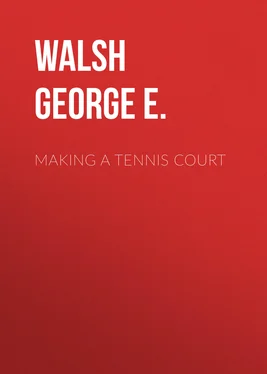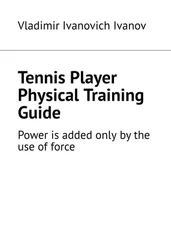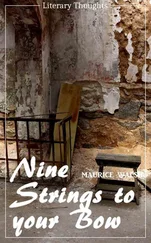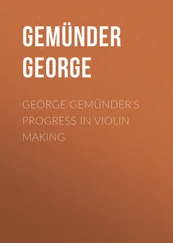George Walsh - Making a Tennis Court
Здесь есть возможность читать онлайн «George Walsh - Making a Tennis Court» — ознакомительный отрывок электронной книги совершенно бесплатно, а после прочтения отрывка купить полную версию. В некоторых случаях можно слушать аудио, скачать через торрент в формате fb2 и присутствует краткое содержание. Жанр: foreign_prose, Спорт, foreign_antique, на английском языке. Описание произведения, (предисловие) а так же отзывы посетителей доступны на портале библиотеки ЛибКат.
- Название:Making a Tennis Court
- Автор:
- Жанр:
- Год:неизвестен
- ISBN:нет данных
- Рейтинг книги:3 / 5. Голосов: 1
-
Избранное:Добавить в избранное
- Отзывы:
-
Ваша оценка:
- 60
- 1
- 2
- 3
- 4
- 5
Making a Tennis Court: краткое содержание, описание и аннотация
Предлагаем к чтению аннотацию, описание, краткое содержание или предисловие (зависит от того, что написал сам автор книги «Making a Tennis Court»). Если вы не нашли необходимую информацию о книге — напишите в комментариях, мы постараемся отыскать её.
Making a Tennis Court — читать онлайн ознакомительный отрывок
Ниже представлен текст книги, разбитый по страницам. Система сохранения места последней прочитанной страницы, позволяет с удобством читать онлайн бесплатно книгу «Making a Tennis Court», без необходимости каждый раз заново искать на чём Вы остановились. Поставьте закладку, и сможете в любой момент перейти на страницу, на которой закончили чтение.
Интервал:
Закладка:
George E. Walsh
Making a Tennis Court
IT is the intention of the publishers to make this series of little volumes, of which Making a Tennis Court is one, a complete library of authoritative and well illustrated handbooks dealing with the activities of the home-maker and amateur gardener. Text, pictures and diagrams will, in each respective book, aim to make perfectly clear the possibility of having, and the means of having, some of the more important features of a modern country or suburban home. Among the titles already issued or planned for early publication are the following: Making a Rose Garden ; Making a Lawn ; Making a Garden to Bloom This Year ; Making a Fireplace ; Making Paths and Driveways ; Making a Poultry House ; Making a Garden with Hotbed and Coldframe ; Making Built-in Bookcases, Shelves and Seats ; Making a Rock Garden ; Making a Water Garden ; Making a Perennial Border ; Making the Grounds Attractive with Shrubbery ; Making a Naturalized Bulb Garden ; with others to be announced later.
There is a great advantage, along the line of appearances, to be had by making the court an integral part of the whole landscape scheme
INTRODUCTION
ALTHOUGH the game of lawn tennis as played to-day dates back only some forty to forty-five years, it is in reality one of the oldest of all existing ball games. The origin of the game is involved in considerable obscurity, but it has numberless historical associations which make it of peculiar interest.
Tennis was mentioned in the Arthurian romances, and it was quite extensively played in Europe in the Middle Ages. It was played upon open courts in the parks or ditches of the feudal castles of France and Italy. It was called, in Italy, giuoco della palla ; in Germany, Ballspiel ; in France, jeu de paume ; and in Spain, jugar al able .
The French borrowed it from the Italians, and the modern word "tennis" was derived from the French exclamation of Tenez! that was employed in serving the ball. It was a game of kings and nobles. Originally a cork ball was used, and this was struck with the palm of the hand. A bank of earth was used instead of a net. The first appearance of the racket is uncertain, but in the time of Henry VII the hand sometimes met the racket on the royal courts of Windsor.
Major Walter C. Wingfield, of the British army, practically modernized and popularized tennis. He patented his game in 1874. It was played on a court 60 × 30 feet, shaped very much like an hour-glass. In this early game of tennis, the net was 7 feet high at the ends, but sagged gradually toward the center to a height of 4 feet 8 inches.
The Marylebone Cricket Club, of Lord's, formulated the first official laws and rules for governing the game in 1875, and the official name of "lawn tennis" was then first adopted. This club set the official length of the court at 78 feet. The width of the court was 30 feet at the base-lines and 24 feet at the nets, which showed that the hour-glass formation was still adhered to. The net itself was 4 feet high in the center and 5 feet at the posts.
From that time to the present, changes have been gradually made, both in the rules and the formation of the courts. The net was gradually lowered and made uniform throughout its length, and the old hour-glass formation was abandoned.
Lawn tennis was brought into this country the same year it appeared in England, 1874. The first court was laid out at Nahant, near Boston, on private grounds, and others soon appeared at Newport, Staten Island, and near Philadelphia. The game grew rapidly in popularity until tens of thousands of people, young and old, were following it as one of the most fascinating of outdoor recreations.
To-day it is one of the most popular of our outdoor games for both sexes, and it has retained its hold upon the public for a good many years in spite of the introduction of other games and the craze for novelties. Tennis gives just the right amount of exhilarating exercise in the open air that one seems to need, and there are hundreds of thousands of devotees of the game who play it regularly throughout the season.
But the possibilities of making the tennis court a great social adjunct to the country place are not always fully appreciated by those who follow the game. Primarily the courts are laid out for practical use, but this should not interfere with their artistic development to make them attractive features of the garden. If one has the land sufficient for a tennis court, it should be utilized with the idea of making it a pleasant place for quiet rest and recreation on warm days.
Making a Tennis Court
LOCATION
THE site for the tennis court should have a perfectly unobstructed space of not less than 60 by 120 feet, and its location should be as conveniently near the house as the topography and landscape architecture will permit. The game is one that is best played in summer in semi-négligée attire, and if the courts are within a reasonable distance of the house there will be no necessity for lockers and dressing rooms. If possible a broad terrace should come between the court and the house, or, if it can be connected with the garden by a broad walk, so much the better. If the country residence is perched on the top or side of a hill, it may be necessary to make the court some distance away on account of the lack of sufficient level area. The architectural features of the house and grounds should in every instance be carefully considered in designing tennis courts, and if the latter are made to harmonize with the former the result is very pleasing to the eye.
The court should be constructed on a site where there is always plenty of sunlight, but there should never be any very light background. A light stucco house, for instance, or an Italian terrace of marble, would make the worst possible backgrounds for a court if located very near it. A light background confuses the players and often makes it impossible for the eyes to follow the ball.
It is a mistake to have a background of foliage for the ends of the courts if it can be avoided. Clear sky as a background makes the balls more readily seen
The site of the court should be, so far as possible, level and with natural drainage, but if these conditions are not present they may be obtained by careful grading and artificial drainage. They increase the cost of building the court considerably, and it may therefore be a question of abandoning an otherwise ideal site for another which is more level and better drained. A court should never be located in a hollow where the surrounding land slopes from all directions toward it. No amount of artificial drainage could keep such a spot dry. A series of grass terraces leading down to the court need not interfere with its construction if the land slopes away from the court in other directions. A blind ditch or drain can be built at the bottom of the last terrace so that surplus water will be carried away from the court.
The site should be selected also according to the nature of the soil, other things being equal. A rocky foundation means a good deal of expense in blasting and hauling of material for the foundation. A very thick clay soil that holds the water a long time is equally unsuited for the court, and the expense of construction is increased by hauling this away and replacing it with a more porous dressing. A natural, fairly sandy soil that is well drained is the ideal for the court, and when this is present the cost of construction will be comparatively light.
But usually the site has to be selected without much regard to the natural soil conditions. If the site is satisfactory in other particulars it is probably more economical in the end to choose it and then attend to the drainage question later. No court will ever amount to much unless it is well drained and well constructed, and these are points that will be considered in detail later. The chief considerations in selecting a site for a court are, therefore, space, light, and drainage.
Читать дальшеИнтервал:
Закладка:
Похожие книги на «Making a Tennis Court»
Представляем Вашему вниманию похожие книги на «Making a Tennis Court» списком для выбора. Мы отобрали схожую по названию и смыслу литературу в надежде предоставить читателям больше вариантов отыскать новые, интересные, ещё непрочитанные произведения.
Обсуждение, отзывы о книге «Making a Tennis Court» и просто собственные мнения читателей. Оставьте ваши комментарии, напишите, что Вы думаете о произведении, его смысле или главных героях. Укажите что конкретно понравилось, а что нет, и почему Вы так считаете.












